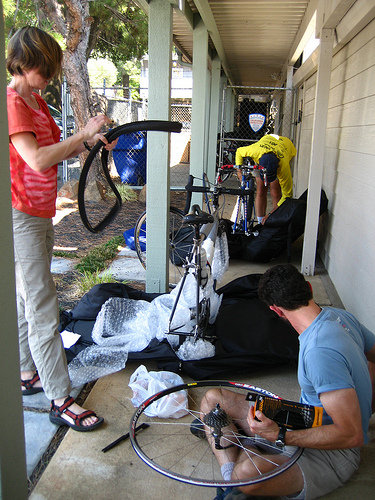Strategy without tactics is the slowest route to victory. Tactics without strategy is the noise before defeat. – Sun Tzu
What does that mean?
At thefreedictionary.com, strategy is defined as “The science and art of military command as applied to the overall planning and conduct of large-scale combat operations” and “A plan of action resulting from strategy or intended to accomplish a specific goal”
At thefreedictionary.com, tactics is defined as “The military science that deals with securing objectives set by strategy, especially the technique of deploying and directing troops, ships, and aircraft in effective maneuvers against an enemy” and also “A procedure or set of maneuvers engaged in to achieve an end, an aim, or a goal”
Wikipedia.org differentiates them as follows: “In military usage strategy is distinct from tactics, which are concerned with the conduct of an engagement, while strategy is concerned with how different engagements are linked. How a battle is fought is a matter of tactics: the terms and conditions that it is fought on and whether it should be fought at all is a matter of strategy”
So, rephrasing: Strategy (a plan) without tactics (implementation) is the slowest path to victory. Tactics (implementation) without strategy (a plan) is the noise before defeat.
And again: A plan without implementation details is the slowest way to do things – you’ll thrash around but eventually you’ll find a way to get there. A set of implementation details without a plan is doomed to failure.
Why are both strategy and tactics important?
Let’s start with a contrasting pair of examples.
Example 1, which will illustrate the first half of the quote. A blueprint of a building without details of how to do the actual assembly (size and shape of footers, the type and size of the block to use, what dimensions of all the lumber to order, the fasteners to use, etc) will eventually be made into a building.
The trades will be able to help identify details, the inspectors will require re-doing of improper work, and eventually it will be completed. It’s not the quickest way to get it done (nor the least expensive), but eventually through trial and error, the building will be finished.
Example 2, which will illustrate the second half of the quote. A sketch of a building on the back of an envelope, even when supported with two dozen full sized sheets giving a of the details of each small part (size and shape of footers, the type and size of the bricks or block to use, how much lumber to order, the fasteners to use, etc) will never yield a building, much less one that looks like the sketch.
Without the over-arching plan, it’s just a bunch of disjointed details. “OK, we dug the hole, here’s one footer. Where does the next footer go?” Or, “Why did you buy 8′ studs when the walls are going to be 9′ tall?” It would end up looking like a Keystone Kops version of a construction site. Not pretty at all.
Another way to explain it is the classic Christmas conundrum – the assembling of a bicycle in the living room at midnight. Some people are sufficiently talented to pull this off without detailed instructions, and some of us have difficulties even with them. But what if you didn’t know what a bicycle was supposed to look like?
If all you had were the detailed steps that showed threading a pedal onto something with a hole in it, how many different ways could that go wrong? Is the hole where the handle bars about the same size as the hole for the seat? Which nut goes with which bolt? Which fastener do you use to hold the front fender on? What about the chain guard, where is the bolt for that? Anyone been there or done that?
Where can I apply this in my life?
Yesterday’s post was all about the strategy side of the saying, so today we will dig a little into the tactics side of the saying. As defined above, the tactics are the actual way you accomplish a task. Dust off the plans you put together yesterday and follow along.
We used cleaning the house as an example, so let’s continue with that example. For an example of tactics, how many ways can you think of to accomplish a task stated as “clean the floor”? I bet you can come up with a few different ways. It could start with de-cluttering, that is picking up books, toys, magazines, game controllers and whatever else is on the floor that really should be somewhere else. But is that clean?
Let’s actually clean the floor. First we need to know what kind of floor it is, as different floors have to be treated in a different manner. For example a wet mop works well on sealed concrete and tile, but not so well on open concrete and carpet. So we get out the vacuum for the carpet and clean it.
Then the hard surfaces (wood, concrete, tile, linoleum, etc) get swept clean. Then the sensitive hard surfaces (wood, open concrete) get a damp mopping to get rid of spills and stains, while the more robust hard surfaces (tile, linoleum, sealed concrete) get the wet mop.
But what about the carpet? Does it have spills or stains? What is the tactics for that? Scrub brush, steam cleaner, hire a pro to clean or a pro to patch the carpet? Depends on the equipment you have, your skill and the nature of the stain. This whole paragraph came from the simple check list item “clean the floor.” Wow, tactics bring a whole new level of detail.
Most of us can do these things automatically with activities that you have done many times before. The tactics are automatic, part of our training. The same thing goes for the Military, they spend almost all their time training, so that when something happens, they are given the strategy and can automatically figure out the tactics needed, based on their training. War is no place for on-the-job training!
Same with professional athletes. They have plans (plays out of their play-book), but their daily training on tactics allows them to handle the small variations that life (and their opponents on game day) will throw at them. A pro infielder does practice catching pop-ups for hours so that when the pitcher’s plan is throwing a pitch so the batter will hit the ball high and short, the infielder knows what he has to do to catch it. Same for ground balls. Outfielders practice running to where the ball will be so they know exactly what to do when the game is on the line.
Where things become tricky is when we aren’t a subject matter expert. Perhaps we’ve read about it, or watched someone on TV do it, but have no actual experience to fall back on. Our tactics are limited to our experience and what we can extrapolate from that experience. For those with limited experience assembling bicycles, Christmas Night can turn into a Christmas Nightmare (just ask my dad).
Tactics, then, are the methods you will use to accomplish an item within the plan. The trick is recognising your limits and planning accordingly, allowing extra time for a re-do or two, to take a class, or to find an expert to do it (or to help). The bicycle could have been assembled at a the house of a friend (who has the tools and knowledge) days in advance, then moved to your garage after bedtime, then up to the tree at midnight, crisis avoided.
Tactics and strategy go hand-in-hand. Now take a look at your plans and circle or highlight anything you are going to need help on. Things you’ve never done, or did once a long time ago, or don’t feel comfortable doing, or don’t have the proper tools or… These are the items you will need help with on the tactical level.
It might be as simple as having someone to call to talk you through things (my brother, the ASE mechanic, has saved my bacon a few times), or a local class to learn a basic skill (like welding). Perhaps it’s a friend who has the tools (like an old college roommate who had access to the tools necessary to make a finely crafted oak book case) or just an extra set of hands to move the bulky or heavy stuff. There are times when I’m wood-working that I adjust my tactics based on what clamps are available or if I have a helper I can call on.
How are your plans looking now? Come up with an idea or two for each highlighted task so that you can add the tactical implications back into the plan. If your plan requires welding and you can’t weld, you’ll need to set aside some money to hire it out, or some time to learn how to weld, or an evening (plus beer and a pizza) to get a buddy to do it for you.
Hopefully your plans (now fortified with tactics) seem a lot more real, and you have ideas on how to cover all the things you weren’t sure how to do. Now you should be out of excuses, so let’s get busy!
From: a wise friend on Twitter
confirmed at: http://www.brainyquote.com/quotes/quotes/s/suntzu129845.html
Photo by randomduck








Pingback: The Benefits of Authors Partnering with Book Marketers | Resources for Writers and Authors
Pingback: My Recent Interview With Ricardo Fayet From Reedsy | Michael Doane, Writer
Useful, thanks.
Glad you found it of some use.
Thanks for stopping by, and for the kind words.
Pingback: If it wasn’t hard… | philosiblog
Pingback: Problems grab us where we are weak… | philosiblog
Pingback: Start by doing what’s necessary… | philosiblog